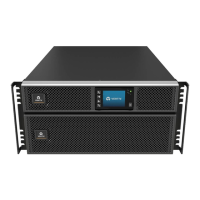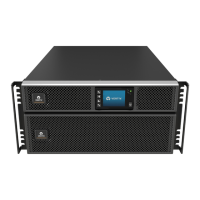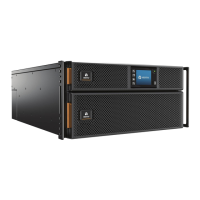Do you have a question about the Vertiv Liebert GXT5-3000IRT2UXL and is the answer not in the manual?
Details the features and available models of the GXT5 UPS, including power ratings.
Details the different operating states and modes of the UPS.
Describes the Normal mode operation, including indicator status and diagram.
Explains Bypass mode operation, indicator status, and diagram.
Describes Battery mode operation, indicator status, and diagram.
Instructions for installing the UPS in either a tower or rack configuration.
Step-by-step guide for installing the UPS in a tower configuration.
Instructions for installing the UPS in a rack enclosure.
Procedures for connecting external battery cabinets to the UPS for extended runtime.
Details on making hardwired electrical connections for input and output.
Guide for connecting a REPO switch to safely shut down the UPS.
Information on configuring GXT5 models in a parallel system for increased capacity.
Steps for the initial startup and parameter setup of a parallel UPS system.
Procedures for commissioning and verifying the operation of a parallel UPS system.
Guide for adding or replacing a UPS unit within an existing parallel system.
Step-by-step instructions for safely starting up the UPS.
Explains how the UPS automatically transfers to battery mode during power failures.
Procedure to manually transfer the UPS from normal operation to bypass mode.
Steps for completely shutting down the UPS and its connected loads.
Detailed procedures for replacing internal UPS batteries, with safety warnings.
A table to determine the cause and solution for common UPS issues.
| Capacity | 3000 VA / 2700 W |
|---|---|
| Output Power | 2700 W |
| Input Voltage | 200-240 VAC |
| Topology | Double Conversion Online |
| Form Factor | Rack/Tower |
| Rack Size | 2U |
| Humidity | 0-95% non-condensing |
| Output Voltage THD | < 3% |
| Efficiency | Up to 94% |
| Battery Type | Sealed Lead-Acid (SLA) |
| Typical Recharge Time | 4 hours to 90% |
| Communication Ports | USB, RS-232 |
| Operating Temperature | 0 to 40°C (32 to 104°F) |
| Storage Temperature | -15 to 45°C (5 to 113°F) |
| Runtime | Varies based on load |











